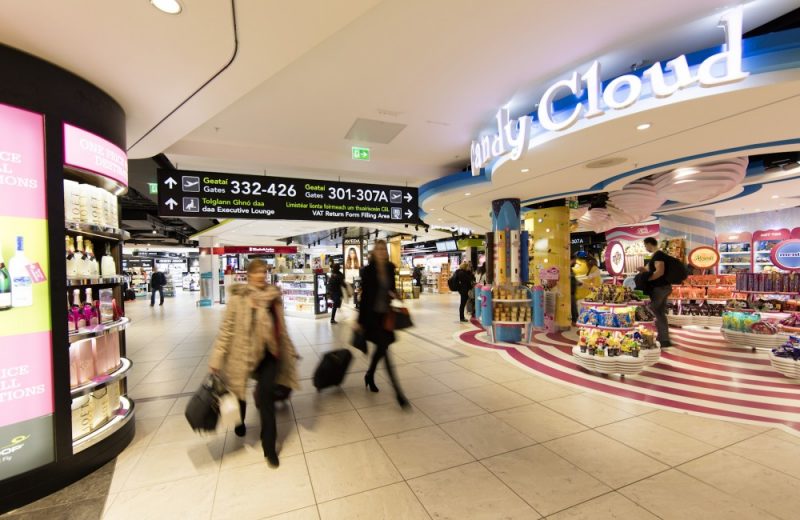
Dublin Airport welcomes its first flights from China in June, 2018 (Image courtesy of Dublin Airport)
While we doubt that anyone travels overseas just to visit an airport, these transit points not only serve as both first and last impressions of a destination, but they also do valuable, often overlooked work to promote inbound tourism. As Chinese tourism continues to take off around the world, international airports are deeply engaged in attracting and accommodating travelers from all over China.
Airports’ experience with and connectivity to China varies a great deal. For example, while LAX welcomes 130 weekly flights from China*, and Helsinki celebrates the 30th anniversary of its first flight to Beijing this June, Dublin Airport launches its first-ever China flights the same month. What’s interesting, though, is that although Helsinki started its China-friendly initiatives 15 years ago, and Dublin kicked off theirs just last year, there is quite a lot of consistency when it comes to what airports do for Chinese passengers around the world. Some may be more technologically savvy than others, or offer more Chinese cuisine, but from the Philippines to Finland, many of the strategies, goals and types of partnerships are the same.
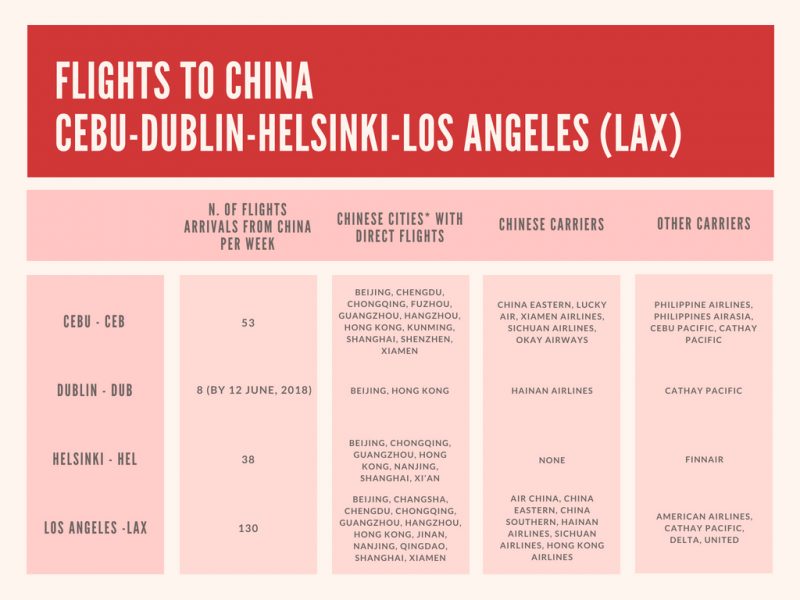
*Although Hong Kong is considered an ‘outbound’ travel destination from China, many international airports include it as a Chinese airport, and it serves as a travel hub for southern China, so we have chosen to include it here.
Communication
The most important factor when it comes to being ready for Chinese travelers has to be communication – both in helping passengers navigate the airport, and guiding them to their onward journey. But there’s an interesting diversity in how airports go about improving communication with Chinese travelers, which offers lots of options to other airports looking to overcome similar challenges and improve their ability to inform and serve.
Information at the terminal
Some airports will find it easier than others to recruit Chinese-speaking staff. For example, Boston is home to the USA’s third-largest Chinatown, and on a recent visit to Logan Airport, Dragon Trail noticed that nearly all of the Duty Free salespeople spoke Mandarin. Los Angeles, an even more international and diverse city, boasts a staff of 175 airport guides, speaking a combined 25 languages, who work at the arrival level of all LAX terminals and at information desks at the Tom Bradley International Terminal. LAX also makes flight announcements in Mandarin and/or Cantonese for all flights to Chinese destination cities.
At Cebu Airport in the Philippines, on the other hand, “Chinese-speaking staff are hard to come by, and it is one of our challenges,” admits Aines Librodo, Head for Airline Marketing and Tourism Development. The airport is working hard to recruit Chinese-speaking customer service staff, but in the meantime, they’ve installed signage around the airport in Chinese and have also developed a cue-card system. These cue cards are written both in English and Chinese, and include answers to frequently asked questions, such as where to find toilets, ATMs or taxis.
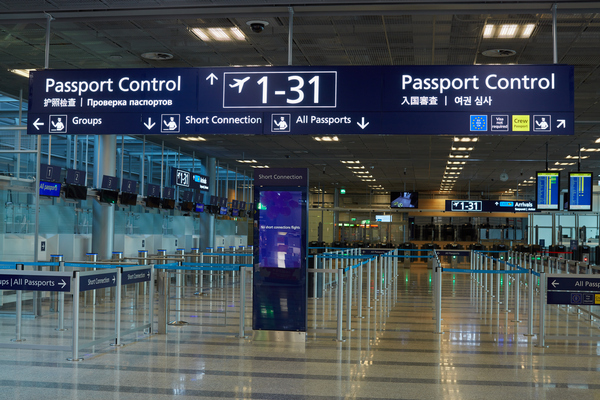
Helsinki Airport has signs in Chinese (Image courtesy of Finavia)
Helsinki is another part of the world without a lot of Chinese speakers, but the airport does have some Mandarin- and Cantonese-speaking staff, whose shifts are planned around the China flight schedules. This is complemented by Chinese signage at the airport, as well as a high-tech solution: a mobile interpretation service called Tulka. Used in Helsinki Airport’s retail shops and customer service stations, Tulka allows staff and passengers to digitally connect to a live interpreter, who can translate between Finnish (or English) and 14 different languages, including Mandarin.
Further resources
Airports also provide extensive information available for passengers to access before their arrivals, using a number of different digital platforms. For visitors to Los Angeles, they can find information on transportation to and from the airport, as well as accommodations, tourist attractions and more on the Chinese website, Hellola.cn. Chinese flying into or out of Helsinki Airport can find information and updates through the airport’s Chinese social media accounts on WeChat, Weibo and Youku and on Lifeinhel.tv, which documents Chinese actor Ryan Zhu’s 30 days spent living at Helsinki Airport (see more on this below).

Cebu Airport’s videos include practical information on the airport, as well as tourism promotion for Cebu
Cebu Airport has tapped into the popularity of video content in China, commissioning a professionally shot and edited video in Mandarin that comprises practical information and destination marketing. The first part of the video “provides instructions on how to process a Philippine visa, what they need to do upon arrival in Cebu Airport such as clearing with immigration and customs, where to change their money, ATMs, taxis, and local transport,” explains Librodo. The second part, called Amazing Cebu, follows five KOLs from China around Cebu for one week, recommending site-seeing locations, activities, adventures, food, shopping, hiking, beaches and more.
Catering
Food
The availability of Chinese or even East Asian cuisine varies a lot among airports, and is often influenced by the location. For example, the Los Angeles area is home to over half a million Chinese-Americans, and LAX has at least four Chinese restaurants. Helsinki Airport, on the other hand, currently has only one Asian-style restaurant, though there are more planned for the future. However, Stana Porvali, Communications Specialist for Finavia Corporation, which runs Helsinki Airport, observes that “most of the passengers want to try local food,” echoing what we’ve heard from many others who work with Chinese outbound tourists.
Hot water
Where the airports tend to agree and have taken similar action is the availability of hot drinking water, as Chinese people are accustomed to drinking hot or warm water and will often bring their own thermoses and tea leaves with them. Siobhan O’Donnell from Dublin Airport says, they “are in close contact with our partners to provide hot water near the gates.” Helsinki Airport has offered two hot water dispensers since 2017, and Cebu Airport is having a hot, warm and cold water dispenser installed this June.
Shopping
Duty Free
Accounting for 13% of global duty free sales, Chinese are by far the world’s leading duty free shoppers, so this part of their airport experience cannot be overlooked. Duty free shops are where you’re most likely to hear Mandarin being spoken in major world airports like Heathrow, and an ever-growing number of airports are starting to accept Chinese mobile payments, as well as China UnionPay cards.
Alipay became available at 10 international airports in 2016, including Frankfurt Airport in Germany. WeChat partnered with an airport for the first time at the end of 2017, launching their service at New Chitose Airport in Hokkaido, Japan. Other airports where Chinese mobile payments can be made at retail shops include JFK and Dulles in the US, Helsinki Airport, Christchurch Airport in New Zealand, Schipol in Amsterdam, and Charles de Gaulle in Paris, among others. Dublin Airport started accepting Alipay in their duty free shops even before getting their first East Asian flight. “We are delighted to say we will be one of the few airports in Europe to provide a Chinese e-payment solution and possibly the first to have it operational prior to a direct flight commencing,” says O’Donnell. Dublin and Helsinki have also both hired “specialized Mandarin-speaking shopping ambassadors” for their retail shops.
In the US, the International Shoppes network, with stores located in five airports in the northeast, accepts UnionPay, Alipay and WeChat Pay. In L.A., the duty free outlets are run by DFS, which is an official China Ready member of the Los Angeles Tourism & Convention Bureau (LATCB), and provides Chinese signage, maps, online tools and Chinese-speaking staff, as well as UnionPay acceptance. China UnionPay is accepted throughout Helsinki Airport and Cebu Airport, too.
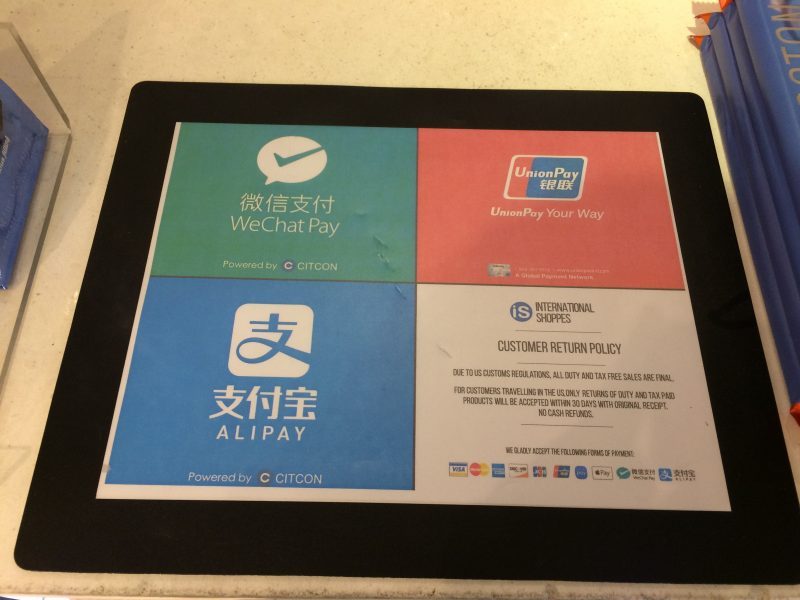
Duty free shops at Boston’s Logan Airport accept WeChat Pay, Alipay and China UnionPay
Cebu Airport also works with all of their retailers and F&B shops to promote Chinese holiday themes throughout the year. “For example, during Chinese New Year, most stores would have Chinese themes, and also during Singles Day, Moon Festival etc.,” says Librodo.
Tax refunds
Not all countries operate a tax refund scheme for visitors, but where this is available, it is very important for Chinese travelers. Long queues, and receiving refunds in local currency are both issues that worry Chinese shoppers, but airports are making changes to ensure that the process goes more smoothly. Chinese tourists at Singapore’s Changi Airport, as well as at Helsinki Airport, can have tax refunds sent straight to their Alipay accounts, and the same is available with WeChat Pay at Barcelona Airport. Dublin Airport is also making tax back facilities available near the departure gate for flights to China and Hong Kong, and Helsinki offers a number of tax refund facilities throughout the airport, which are all clearly listed on their website.
Marketing & partnerships
B2C: Social media
Not all international airports have WeChat accounts, but Helsinki, Cebu and Dublin all do, and Helsinki has Weibo and Youku accounts, too. Dublin Airport, which has won awards for their Western social media, has just launched both WeChat and Weibo accounts. As O’Donnell explains, “We are acutely aware of how important digital content and social media is for our Chinese visitors, and how different the digital ecosystem is in China. [Our] WeChat account … will be tailored and personalized to the Chinese audience. It will be a platform to drive engagement between the Chinese passengers, Dublin Airport and Ireland, with both exciting tourism content and informative tools to make their journey as smooth and pleasant as possible. Even beyond that, it will be a great platform to inform our passengers of our retail offers and tailored promotions.” While LAX does not have its own WeChat account, LATCB helps the airport to promote its services and new routes on Discover L.A.’s website and social media channels in China.
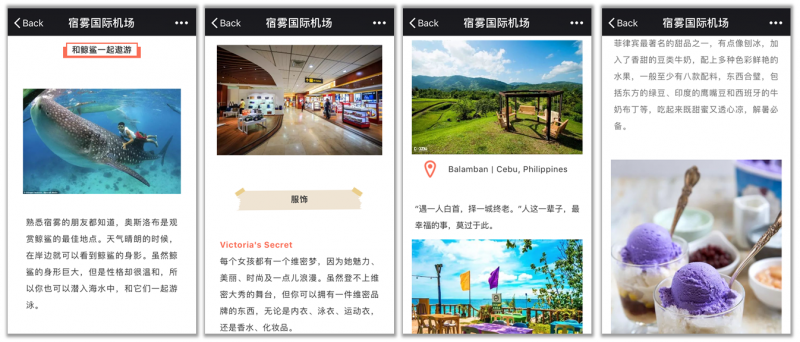
Cebu Airport’s WeChat account publishes information about what do do, where to stay and what to eat in Cebu, in addition to information and news about the airport’s services
B2C: Video
In addition to Cebu Airport’s informational videos discussed earlier, other airports have also made video marketing part of their strategy – both to China and the world more generally. In 2018, LAX organized a ‘Welcome to L.A.’ marketing activity, where hundreds of Los Angeles citizens greeted arriving airplanes with hand-held placards, which, together, spelled out ‘Welcome’ in a number of different languages, one of which was (simplified) Chinese. This activity was featured in LACTB’s ‘Welcome to Los Angeles’ destination marketing video, which won the Tripshow video contest in China in 2017.

‘Welcome, China’ reads the message displayed at LAX for a flight arriving from China. This featured in LATCB’s tourism marketing video.
Helsinki Airport, which “cooperate[s] widely with organizations like Visit Finland, Business Finland, Helsinki Marketing, House of Lapland, and all airlines to promote Finland as a destination” worked together with these other stakeholders to put together a massive marketing campaign and video project in the autumn of 2017, called #LIFEINHEL. The campaign challenged Chinese actor Ryan Zhu to live at Helsinki Airport for 30 days, an experience which was filmed for a short video series. #LIFEINHEL not only got 10 million video views, but the airport also took on Zhu’s feedback after his month in the airport – he encouraged them to increase both their Chinese food offerings (but, unlike most passengers, he was there for an entire month) and Chinese-speaking staff.
B2C: Holiday events
In addition to retail promotions, Chinese holidays are often used by airports to welcome Chinese passengers on a cultural level – especially as certain holiday periods, such as Chinese New Year, see a surge in outbound travel. During Chinese New Year 2018, Helsinki Airport gave out red envelopes to all passengers from China, filled with vouchers to airport outlets and chocolate coins. In Los Angeles, LAX’s retail operator Westfield holds annual Chinese New Year celebrations, complete with lion dances at various LAX terminals.
B2B
Strong partnerships are a valuable part of airports’ B2B work. Cebu Airport cooperates with the Philippines Department of Tourism on their annual roadshows to key cities in China. “We visit both the airlines and the tour operators/travel agents, and even charterers (to showcase the destination). So far, we have been to Shanghai, Beijing, Tianjin, Xi’an, Shenzhen, Guangzhou, Chongqing and Chengdu. We also invite the travel agents and the airlines for a familiarization trip here in Cebu,” says Librodo. Similarly, LAX works together closely with LATCB on industry roadshows, sales missions and air service familiarization trips for media and members of the travel industry.
Helsinki participates in industry events in China, such as ITB Shanghai and World Routes in Guangzhou. One of their other initiatives is a partnership with Beijing Capital International Airport, which includes the exchange of both information and employees – a program that can go a long way to ensuring that airport staff understand the needs and expectations of Chinese travelers.
Policy and logistics
Aside from marketing, one of the key areas where tourism boards and airports support each other is on establishing air routes and lobbying for policies that will encourage the growth of Chinese tourism. Dublin has worked “closely with Tourism Ireland to promote and secure air route access to the Chinese market,” and Helsinki Airport company Finavia, along with Finnair and the Finnish Transport Safety Agency Trafi, all joined the Finnish Ministry of Transport and Communications to form the committee that updated the air services agreement between Finland and China in April 2017. Going even further, Cebu Airport and the Philippines Department of Tourism not only share information and work to develop air connectivity between Cebu and China, but they “also work together to lobby for a much friendlier and liberalized visa processing for our Chinese visitors,” says Librodo.
Gateways to travel
Duty free retail might be the first thing that comes to mind when thinking about what airports do for Chinese travelers, but these travel hubs are responsible for much more, and can have a real impact on the healthy development of Chinese tourism. Not only is it important for airports themselves to realize this, and make sure that their communication tools and amenities are adapted for Chinese travelers, but it’s also crucial that both airlines and tourism bodies appreciate the role of the airport and take advantage of what a strong working relationship with an airport can provide.
Sign up for our free newsletter to keep up to date on our latest news
We do not share your details with any third parties. View our privacy policy.
This website or its third party tools use cookies, which are necessary to its functioning and required to achieve the purposes illustrated in the cookie policy. If you want to know more or withdraw your consent to all or some of the cookies, please refer to the cookie policy. By closing this banner, scrolling this page, clicking a link or continuing to browse otherwise, you agree to the use of cookies.